Taxation: Comprehensive Analysis of S Corporations and Partnerships
VerifiedAdded on 2023/05/28
|8
|1333
|391
Homework Assignment
AI Summary
This assignment provides detailed solutions to questions concerning the taxation of S corporations and partnerships. It covers topics such as eligibility requirements for S corporations, stock basis adjustments, built-in gains tax, and the application of partnership tax rules. The solutions address various scenarios related to contributions, distributions, and liabilities in both S corporations and partnerships, offering clear explanations and calculations. The assignment also clarifies common misconceptions about S corporation and partnership taxation, providing a comprehensive overview of the key principles and regulations governing these business structures. Desklib offers a platform to access more solved assignments and study resources for students.
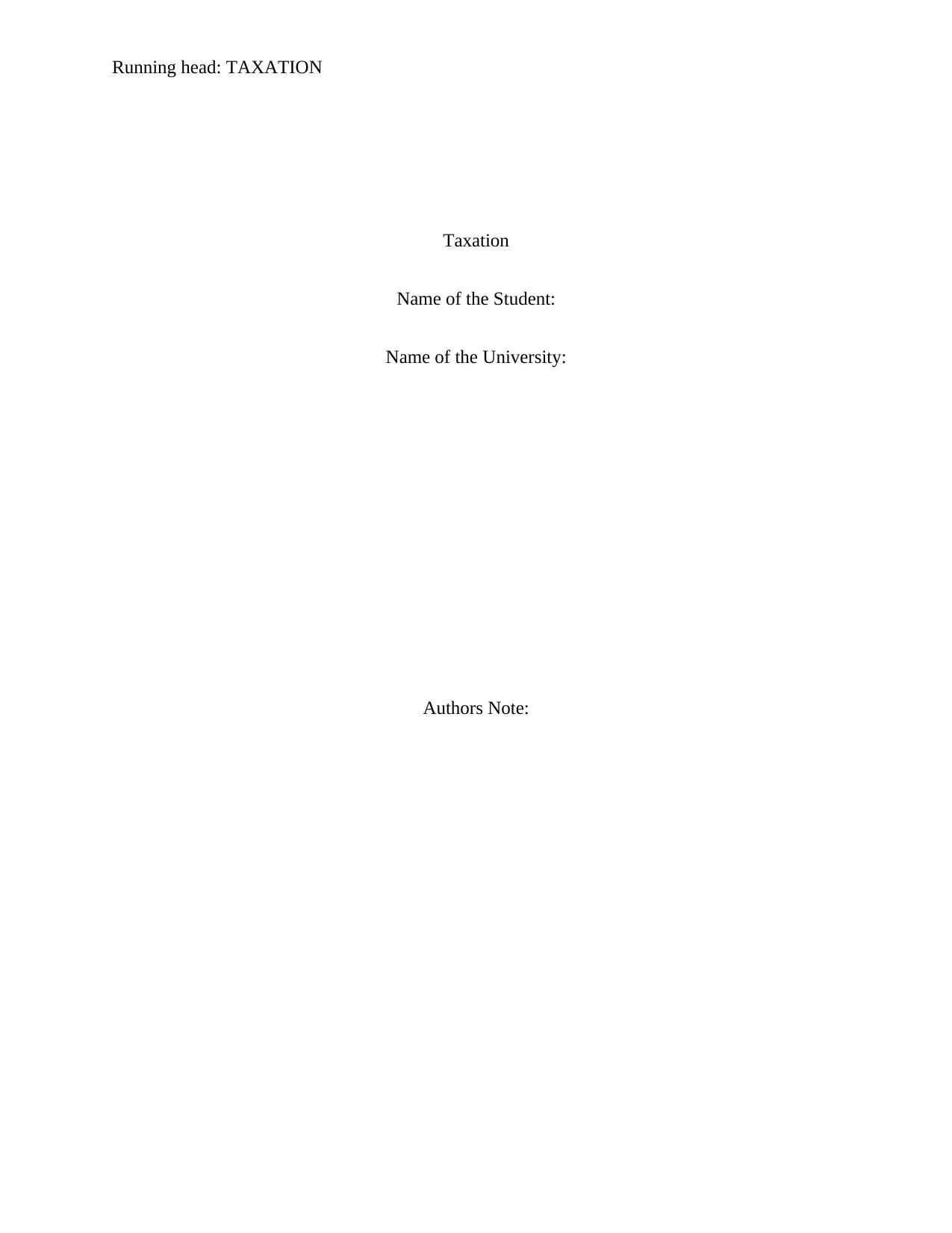
Running head: TAXATION
Taxation
Name of the Student:
Name of the University:
Authors Note:
Taxation
Name of the Student:
Name of the University:
Authors Note:
Paraphrase This Document
Need a fresh take? Get an instant paraphrase of this document with our AI Paraphraser
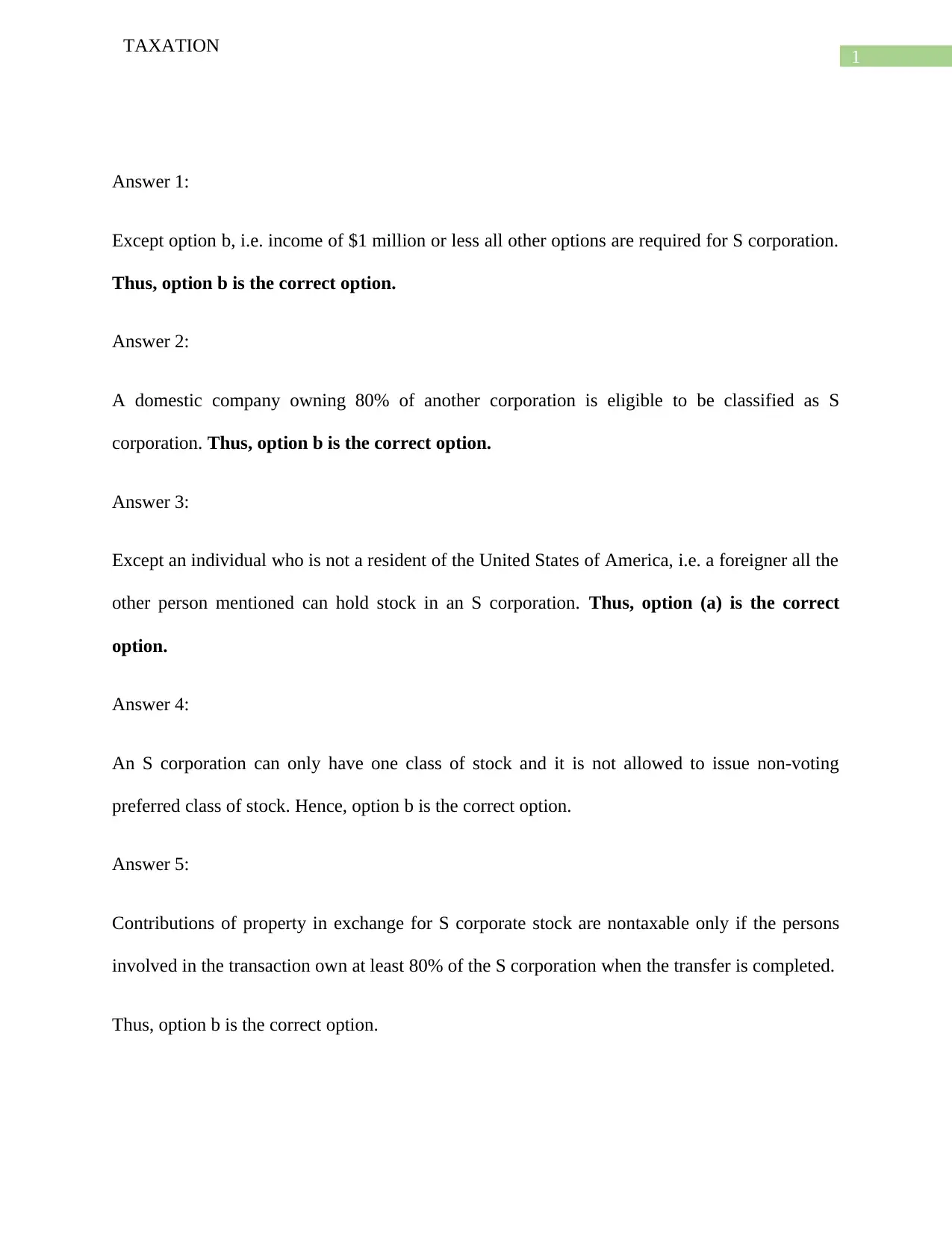
1
TAXATION
Answer 1:
Except option b, i.e. income of $1 million or less all other options are required for S corporation.
Thus, option b is the correct option.
Answer 2:
A domestic company owning 80% of another corporation is eligible to be classified as S
corporation. Thus, option b is the correct option.
Answer 3:
Except an individual who is not a resident of the United States of America, i.e. a foreigner all the
other person mentioned can hold stock in an S corporation. Thus, option (a) is the correct
option.
Answer 4:
An S corporation can only have one class of stock and it is not allowed to issue non-voting
preferred class of stock. Hence, option b is the correct option.
Answer 5:
Contributions of property in exchange for S corporate stock are nontaxable only if the persons
involved in the transaction own at least 80% of the S corporation when the transfer is completed.
Thus, option b is the correct option.
TAXATION
Answer 1:
Except option b, i.e. income of $1 million or less all other options are required for S corporation.
Thus, option b is the correct option.
Answer 2:
A domestic company owning 80% of another corporation is eligible to be classified as S
corporation. Thus, option b is the correct option.
Answer 3:
Except an individual who is not a resident of the United States of America, i.e. a foreigner all the
other person mentioned can hold stock in an S corporation. Thus, option (a) is the correct
option.
Answer 4:
An S corporation can only have one class of stock and it is not allowed to issue non-voting
preferred class of stock. Hence, option b is the correct option.
Answer 5:
Contributions of property in exchange for S corporate stock are nontaxable only if the persons
involved in the transaction own at least 80% of the S corporation when the transfer is completed.
Thus, option b is the correct option.
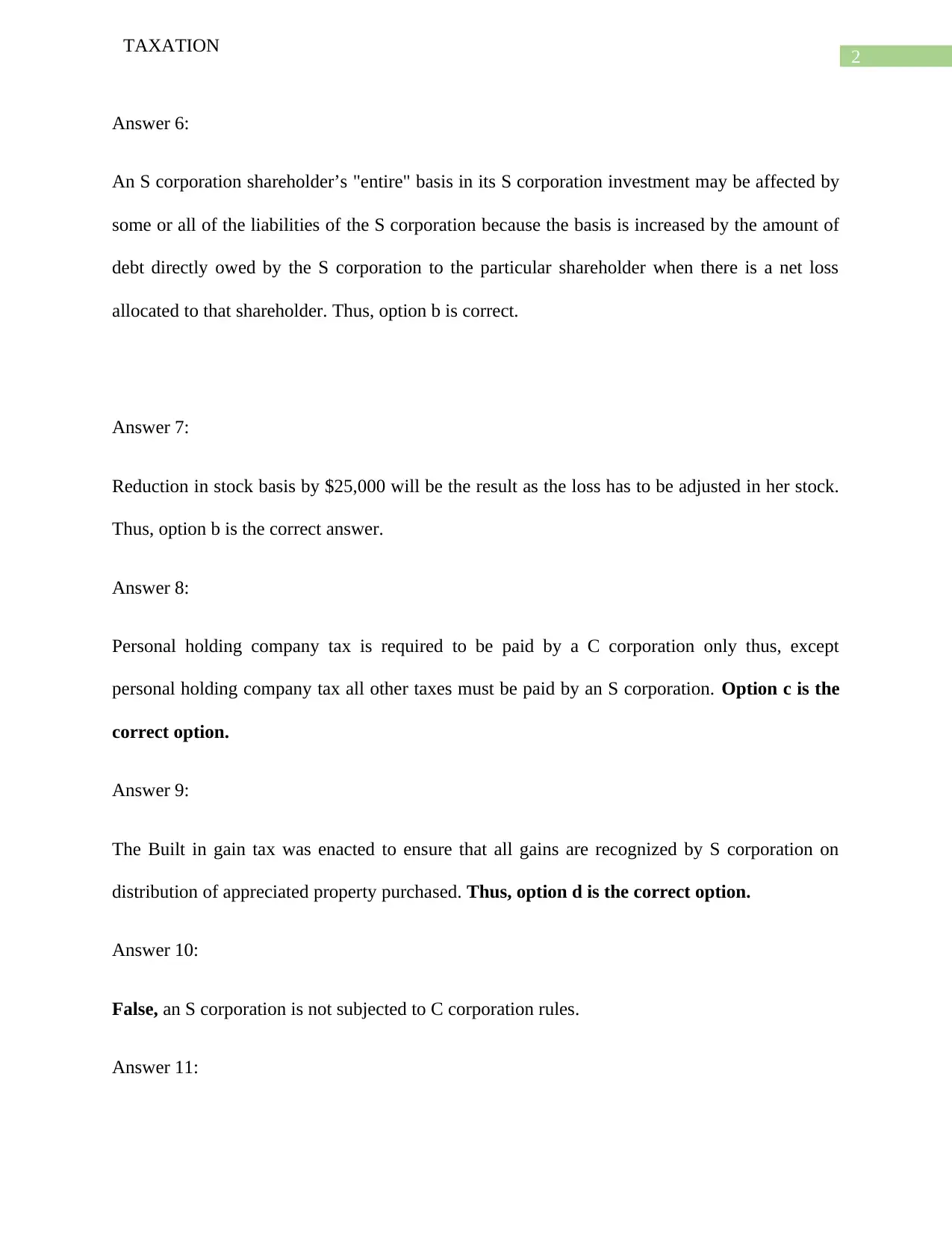
2
TAXATION
Answer 6:
An S corporation shareholder’s "entire" basis in its S corporation investment may be affected by
some or all of the liabilities of the S corporation because the basis is increased by the amount of
debt directly owed by the S corporation to the particular shareholder when there is a net loss
allocated to that shareholder. Thus, option b is correct.
Answer 7:
Reduction in stock basis by $25,000 will be the result as the loss has to be adjusted in her stock.
Thus, option b is the correct answer.
Answer 8:
Personal holding company tax is required to be paid by a C corporation only thus, except
personal holding company tax all other taxes must be paid by an S corporation. Option c is the
correct option.
Answer 9:
The Built in gain tax was enacted to ensure that all gains are recognized by S corporation on
distribution of appreciated property purchased. Thus, option d is the correct option.
Answer 10:
False, an S corporation is not subjected to C corporation rules.
Answer 11:
TAXATION
Answer 6:
An S corporation shareholder’s "entire" basis in its S corporation investment may be affected by
some or all of the liabilities of the S corporation because the basis is increased by the amount of
debt directly owed by the S corporation to the particular shareholder when there is a net loss
allocated to that shareholder. Thus, option b is correct.
Answer 7:
Reduction in stock basis by $25,000 will be the result as the loss has to be adjusted in her stock.
Thus, option b is the correct answer.
Answer 8:
Personal holding company tax is required to be paid by a C corporation only thus, except
personal holding company tax all other taxes must be paid by an S corporation. Option c is the
correct option.
Answer 9:
The Built in gain tax was enacted to ensure that all gains are recognized by S corporation on
distribution of appreciated property purchased. Thus, option d is the correct option.
Answer 10:
False, an S corporation is not subjected to C corporation rules.
Answer 11:
⊘ This is a preview!⊘
Do you want full access?
Subscribe today to unlock all pages.

Trusted by 1+ million students worldwide
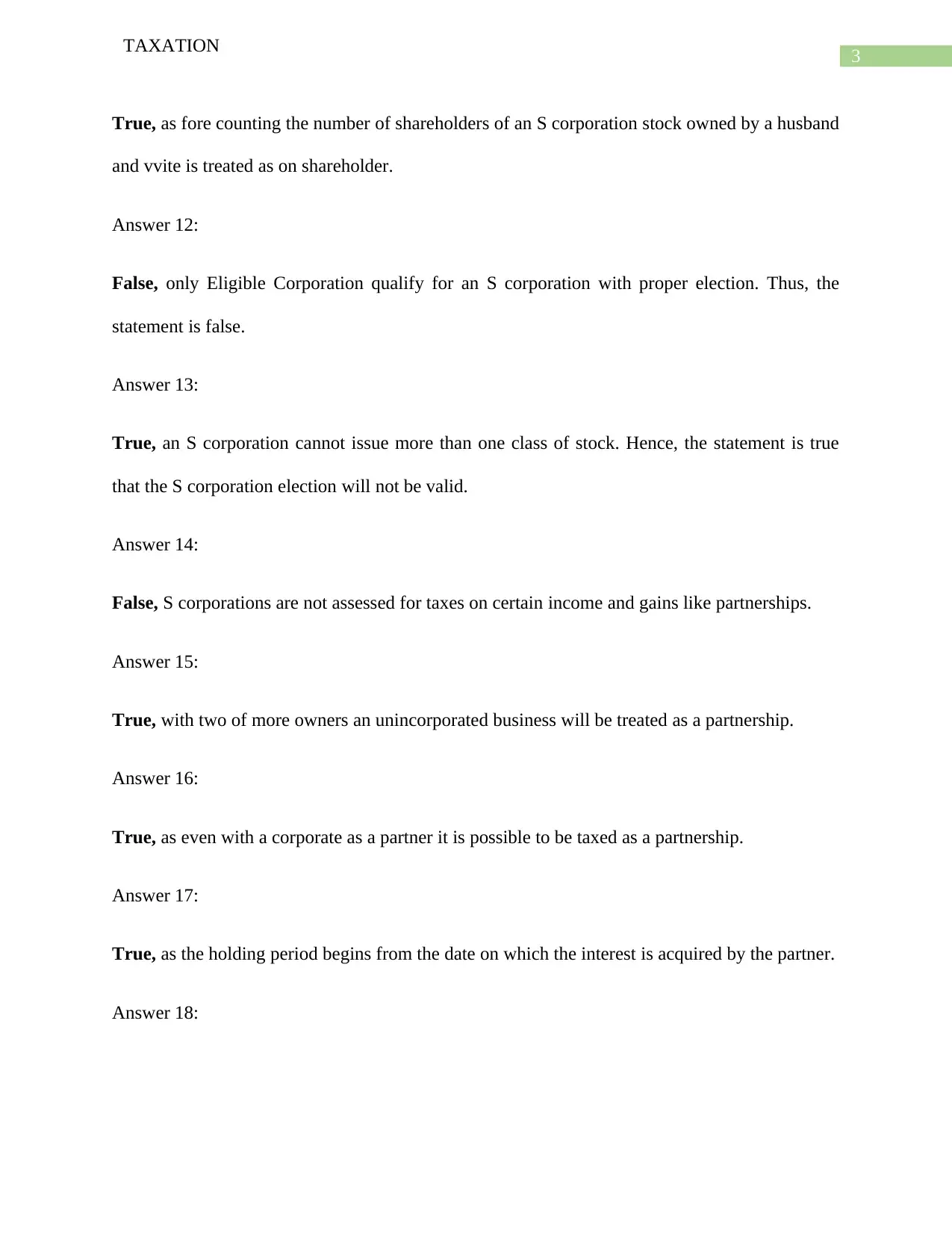
3
TAXATION
True, as fore counting the number of shareholders of an S corporation stock owned by a husband
and vvite is treated as on shareholder.
Answer 12:
False, only Eligible Corporation qualify for an S corporation with proper election. Thus, the
statement is false.
Answer 13:
True, an S corporation cannot issue more than one class of stock. Hence, the statement is true
that the S corporation election will not be valid.
Answer 14:
False, S corporations are not assessed for taxes on certain income and gains like partnerships.
Answer 15:
True, with two of more owners an unincorporated business will be treated as a partnership.
Answer 16:
True, as even with a corporate as a partner it is possible to be taxed as a partnership.
Answer 17:
True, as the holding period begins from the date on which the interest is acquired by the partner.
Answer 18:
TAXATION
True, as fore counting the number of shareholders of an S corporation stock owned by a husband
and vvite is treated as on shareholder.
Answer 12:
False, only Eligible Corporation qualify for an S corporation with proper election. Thus, the
statement is false.
Answer 13:
True, an S corporation cannot issue more than one class of stock. Hence, the statement is true
that the S corporation election will not be valid.
Answer 14:
False, S corporations are not assessed for taxes on certain income and gains like partnerships.
Answer 15:
True, with two of more owners an unincorporated business will be treated as a partnership.
Answer 16:
True, as even with a corporate as a partner it is possible to be taxed as a partnership.
Answer 17:
True, as the holding period begins from the date on which the interest is acquired by the partner.
Answer 18:
Paraphrase This Document
Need a fresh take? Get an instant paraphrase of this document with our AI Paraphraser
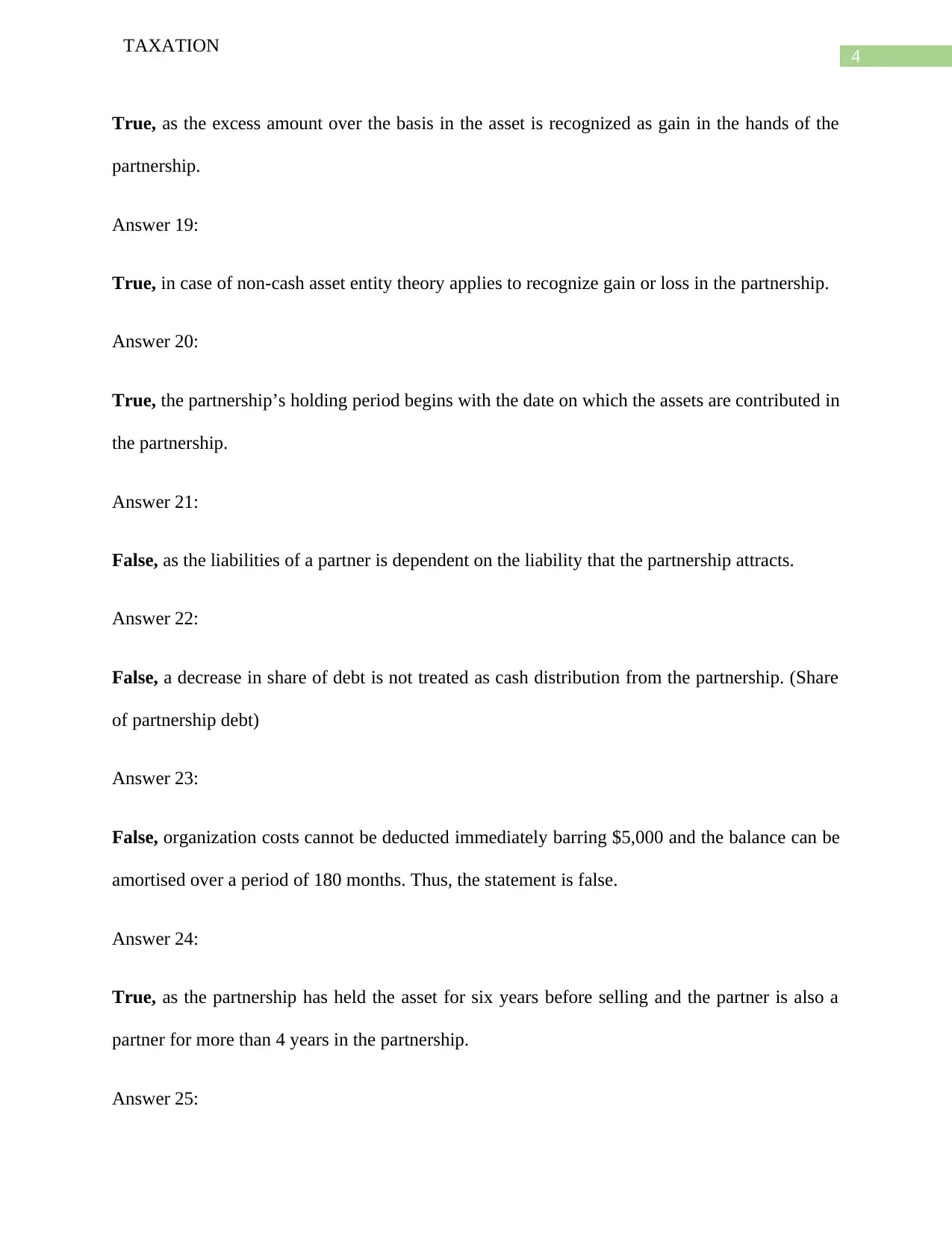
4
TAXATION
True, as the excess amount over the basis in the asset is recognized as gain in the hands of the
partnership.
Answer 19:
True, in case of non-cash asset entity theory applies to recognize gain or loss in the partnership.
Answer 20:
True, the partnership’s holding period begins with the date on which the assets are contributed in
the partnership.
Answer 21:
False, as the liabilities of a partner is dependent on the liability that the partnership attracts.
Answer 22:
False, a decrease in share of debt is not treated as cash distribution from the partnership. (Share
of partnership debt)
Answer 23:
False, organization costs cannot be deducted immediately barring $5,000 and the balance can be
amortised over a period of 180 months. Thus, the statement is false.
Answer 24:
True, as the partnership has held the asset for six years before selling and the partner is also a
partner for more than 4 years in the partnership.
Answer 25:
TAXATION
True, as the excess amount over the basis in the asset is recognized as gain in the hands of the
partnership.
Answer 19:
True, in case of non-cash asset entity theory applies to recognize gain or loss in the partnership.
Answer 20:
True, the partnership’s holding period begins with the date on which the assets are contributed in
the partnership.
Answer 21:
False, as the liabilities of a partner is dependent on the liability that the partnership attracts.
Answer 22:
False, a decrease in share of debt is not treated as cash distribution from the partnership. (Share
of partnership debt)
Answer 23:
False, organization costs cannot be deducted immediately barring $5,000 and the balance can be
amortised over a period of 180 months. Thus, the statement is false.
Answer 24:
True, as the partnership has held the asset for six years before selling and the partner is also a
partner for more than 4 years in the partnership.
Answer 25:
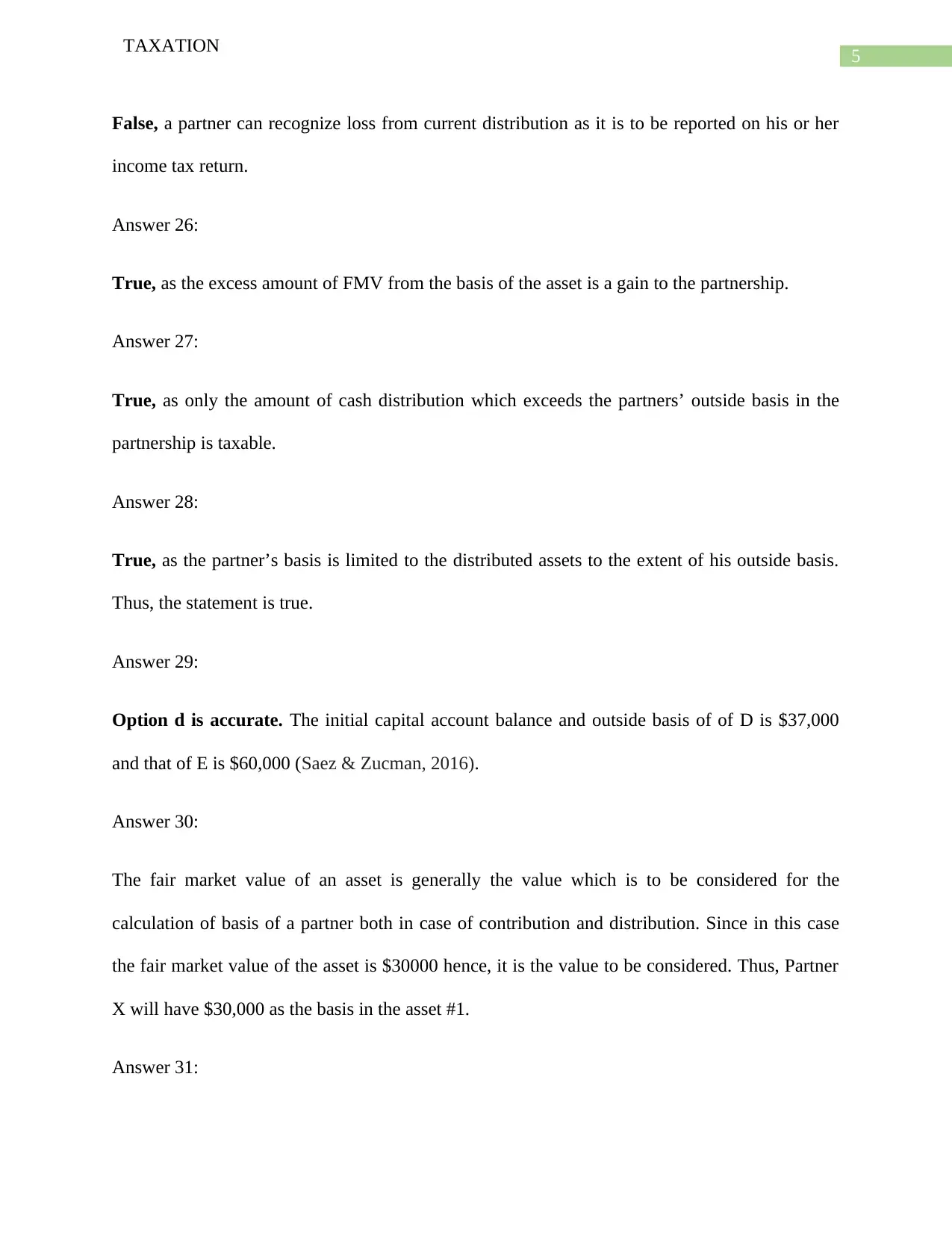
5
TAXATION
False, a partner can recognize loss from current distribution as it is to be reported on his or her
income tax return.
Answer 26:
True, as the excess amount of FMV from the basis of the asset is a gain to the partnership.
Answer 27:
True, as only the amount of cash distribution which exceeds the partners’ outside basis in the
partnership is taxable.
Answer 28:
True, as the partner’s basis is limited to the distributed assets to the extent of his outside basis.
Thus, the statement is true.
Answer 29:
Option d is accurate. The initial capital account balance and outside basis of of D is $37,000
and that of E is $60,000 (Saez & Zucman, 2016).
Answer 30:
The fair market value of an asset is generally the value which is to be considered for the
calculation of basis of a partner both in case of contribution and distribution. Since in this case
the fair market value of the asset is $30000 hence, it is the value to be considered. Thus, Partner
X will have $30,000 as the basis in the asset #1.
Answer 31:
TAXATION
False, a partner can recognize loss from current distribution as it is to be reported on his or her
income tax return.
Answer 26:
True, as the excess amount of FMV from the basis of the asset is a gain to the partnership.
Answer 27:
True, as only the amount of cash distribution which exceeds the partners’ outside basis in the
partnership is taxable.
Answer 28:
True, as the partner’s basis is limited to the distributed assets to the extent of his outside basis.
Thus, the statement is true.
Answer 29:
Option d is accurate. The initial capital account balance and outside basis of of D is $37,000
and that of E is $60,000 (Saez & Zucman, 2016).
Answer 30:
The fair market value of an asset is generally the value which is to be considered for the
calculation of basis of a partner both in case of contribution and distribution. Since in this case
the fair market value of the asset is $30000 hence, it is the value to be considered. Thus, Partner
X will have $30,000 as the basis in the asset #1.
Answer 31:
⊘ This is a preview!⊘
Do you want full access?
Subscribe today to unlock all pages.

Trusted by 1+ million students worldwide
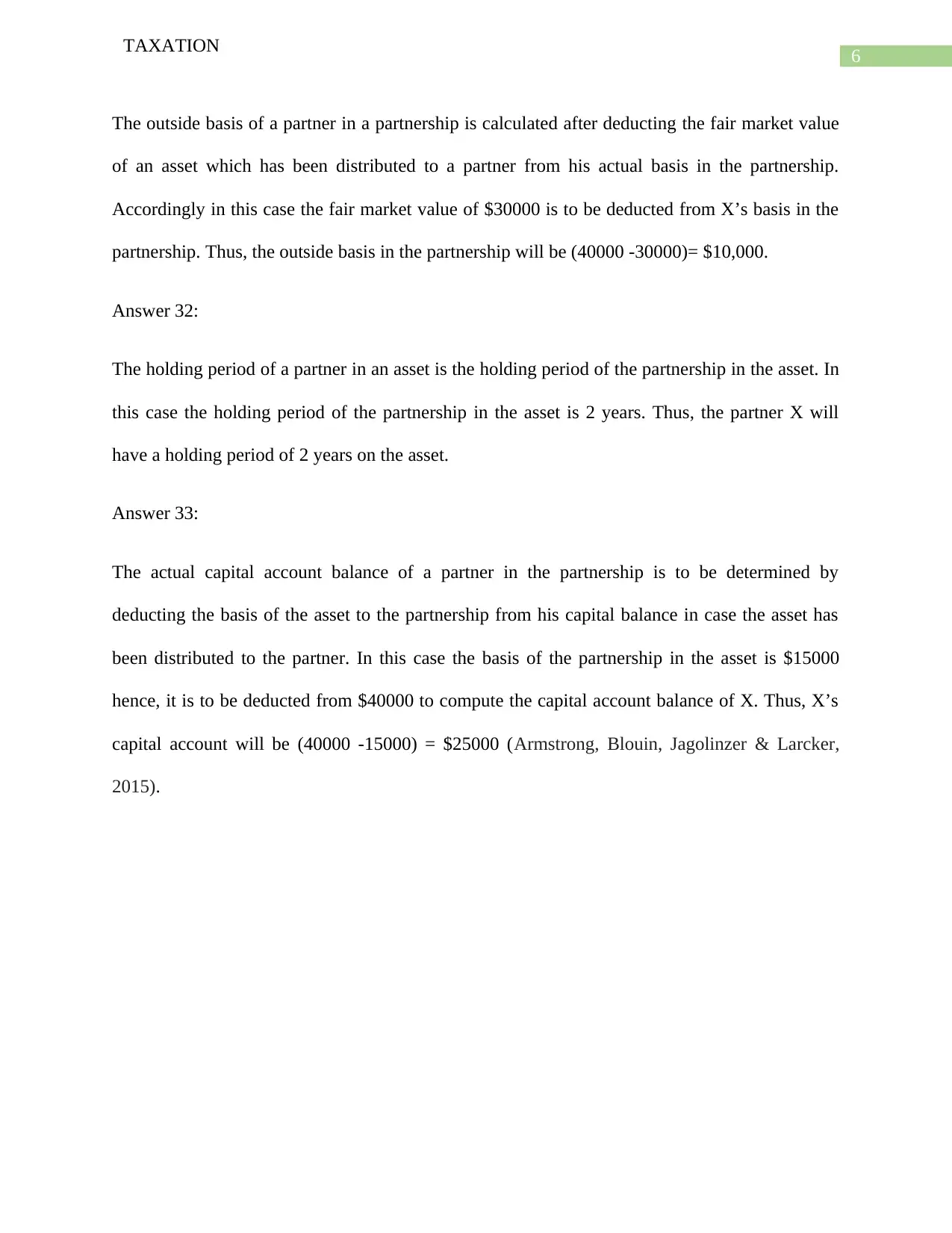
6
TAXATION
The outside basis of a partner in a partnership is calculated after deducting the fair market value
of an asset which has been distributed to a partner from his actual basis in the partnership.
Accordingly in this case the fair market value of $30000 is to be deducted from X’s basis in the
partnership. Thus, the outside basis in the partnership will be (40000 -30000)= $10,000.
Answer 32:
The holding period of a partner in an asset is the holding period of the partnership in the asset. In
this case the holding period of the partnership in the asset is 2 years. Thus, the partner X will
have a holding period of 2 years on the asset.
Answer 33:
The actual capital account balance of a partner in the partnership is to be determined by
deducting the basis of the asset to the partnership from his capital balance in case the asset has
been distributed to the partner. In this case the basis of the partnership in the asset is $15000
hence, it is to be deducted from $40000 to compute the capital account balance of X. Thus, X’s
capital account will be (40000 -15000) = $25000 (Armstrong, Blouin, Jagolinzer & Larcker,
2015).
TAXATION
The outside basis of a partner in a partnership is calculated after deducting the fair market value
of an asset which has been distributed to a partner from his actual basis in the partnership.
Accordingly in this case the fair market value of $30000 is to be deducted from X’s basis in the
partnership. Thus, the outside basis in the partnership will be (40000 -30000)= $10,000.
Answer 32:
The holding period of a partner in an asset is the holding period of the partnership in the asset. In
this case the holding period of the partnership in the asset is 2 years. Thus, the partner X will
have a holding period of 2 years on the asset.
Answer 33:
The actual capital account balance of a partner in the partnership is to be determined by
deducting the basis of the asset to the partnership from his capital balance in case the asset has
been distributed to the partner. In this case the basis of the partnership in the asset is $15000
hence, it is to be deducted from $40000 to compute the capital account balance of X. Thus, X’s
capital account will be (40000 -15000) = $25000 (Armstrong, Blouin, Jagolinzer & Larcker,
2015).
Paraphrase This Document
Need a fresh take? Get an instant paraphrase of this document with our AI Paraphraser
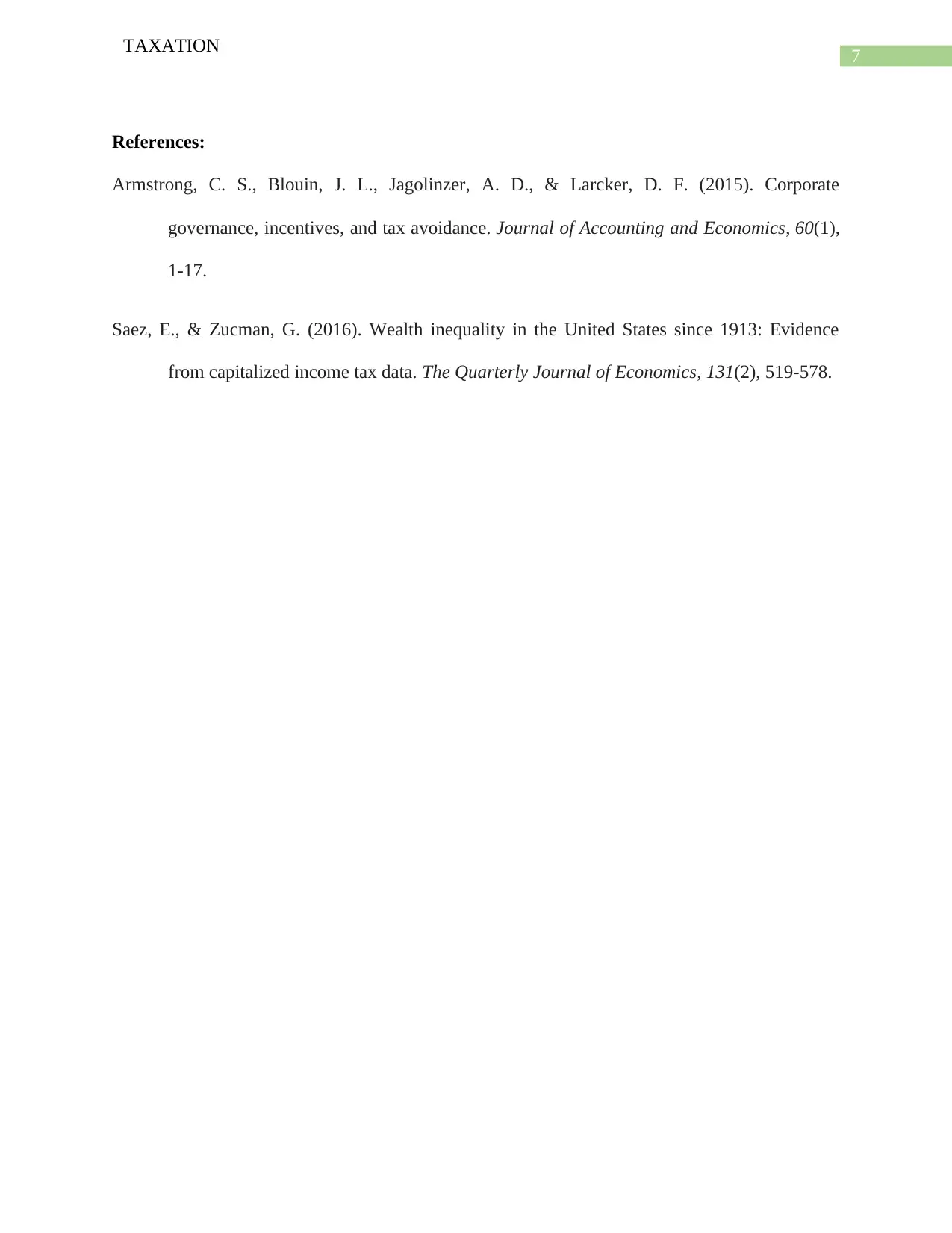
7
TAXATION
References:
Armstrong, C. S., Blouin, J. L., Jagolinzer, A. D., & Larcker, D. F. (2015). Corporate
governance, incentives, and tax avoidance. Journal of Accounting and Economics, 60(1),
1-17.
Saez, E., & Zucman, G. (2016). Wealth inequality in the United States since 1913: Evidence
from capitalized income tax data. The Quarterly Journal of Economics, 131(2), 519-578.
TAXATION
References:
Armstrong, C. S., Blouin, J. L., Jagolinzer, A. D., & Larcker, D. F. (2015). Corporate
governance, incentives, and tax avoidance. Journal of Accounting and Economics, 60(1),
1-17.
Saez, E., & Zucman, G. (2016). Wealth inequality in the United States since 1913: Evidence
from capitalized income tax data. The Quarterly Journal of Economics, 131(2), 519-578.
1 out of 8
Related Documents
Your All-in-One AI-Powered Toolkit for Academic Success.
+13062052269
info@desklib.com
Available 24*7 on WhatsApp / Email
![[object Object]](/_next/static/media/star-bottom.7253800d.svg)
Unlock your academic potential
Copyright © 2020–2025 A2Z Services. All Rights Reserved. Developed and managed by ZUCOL.



